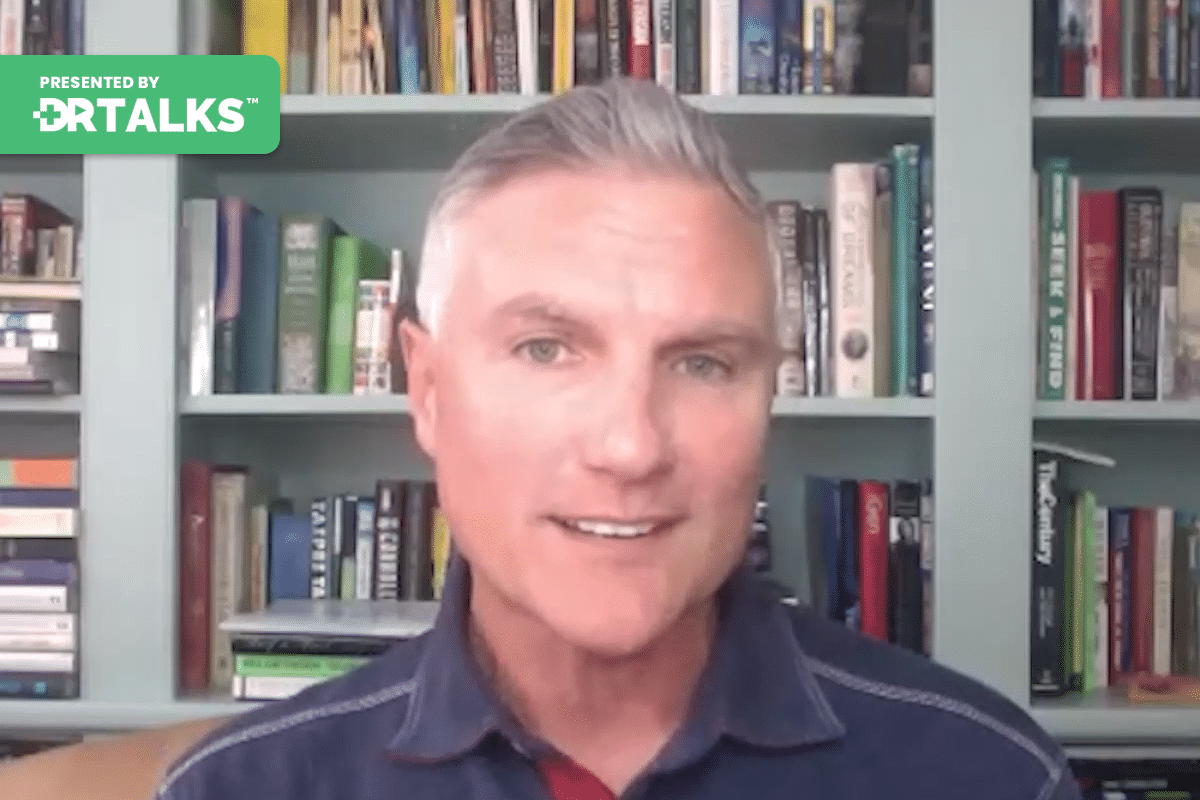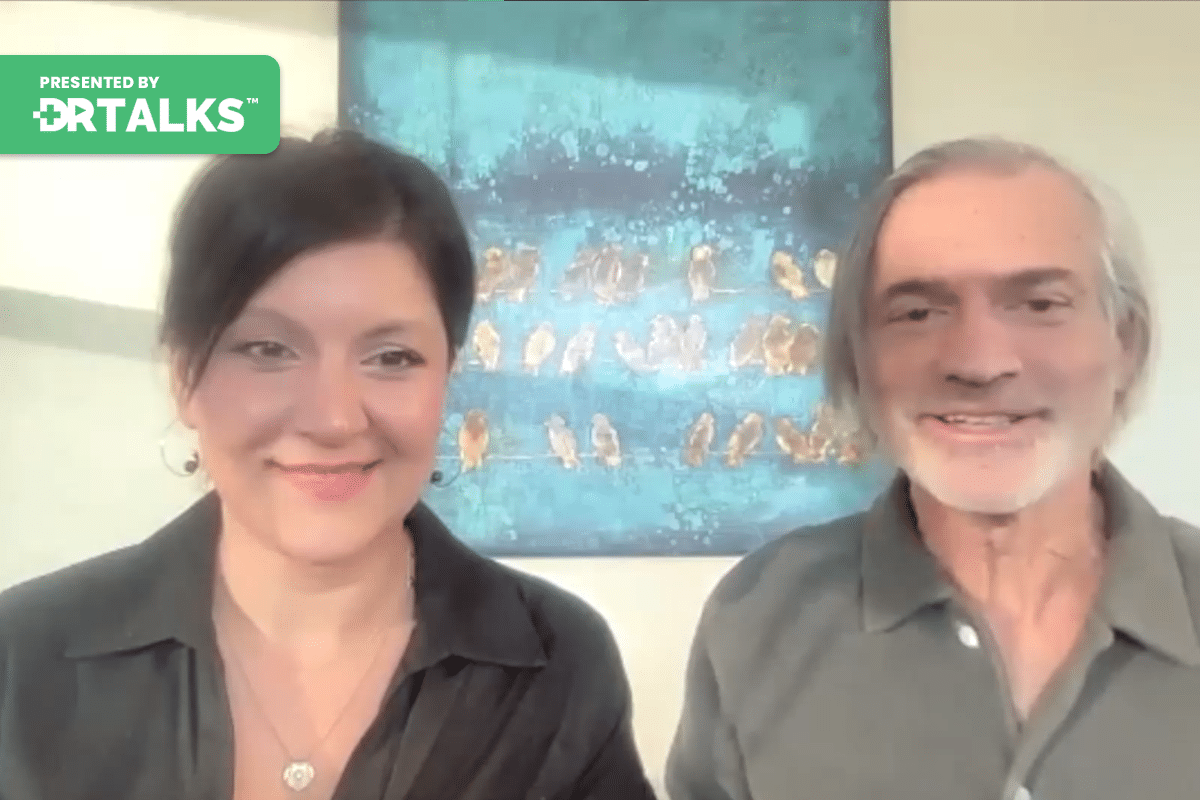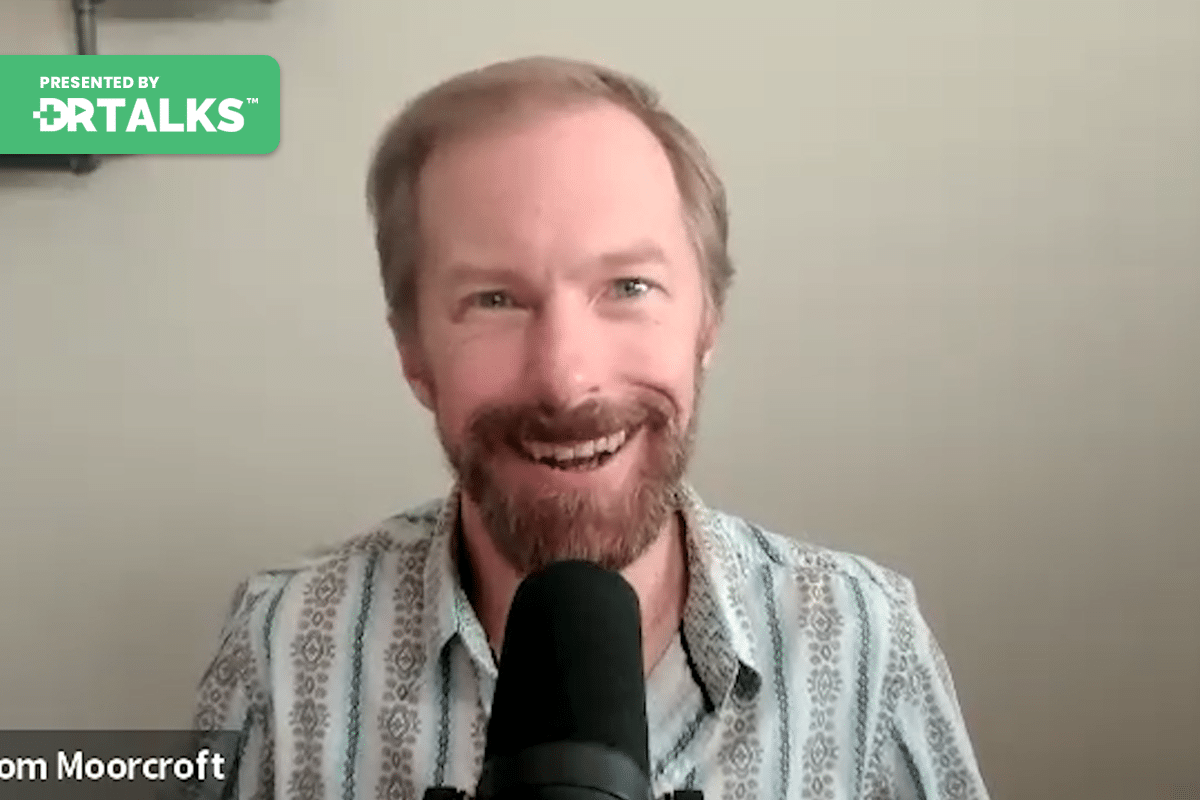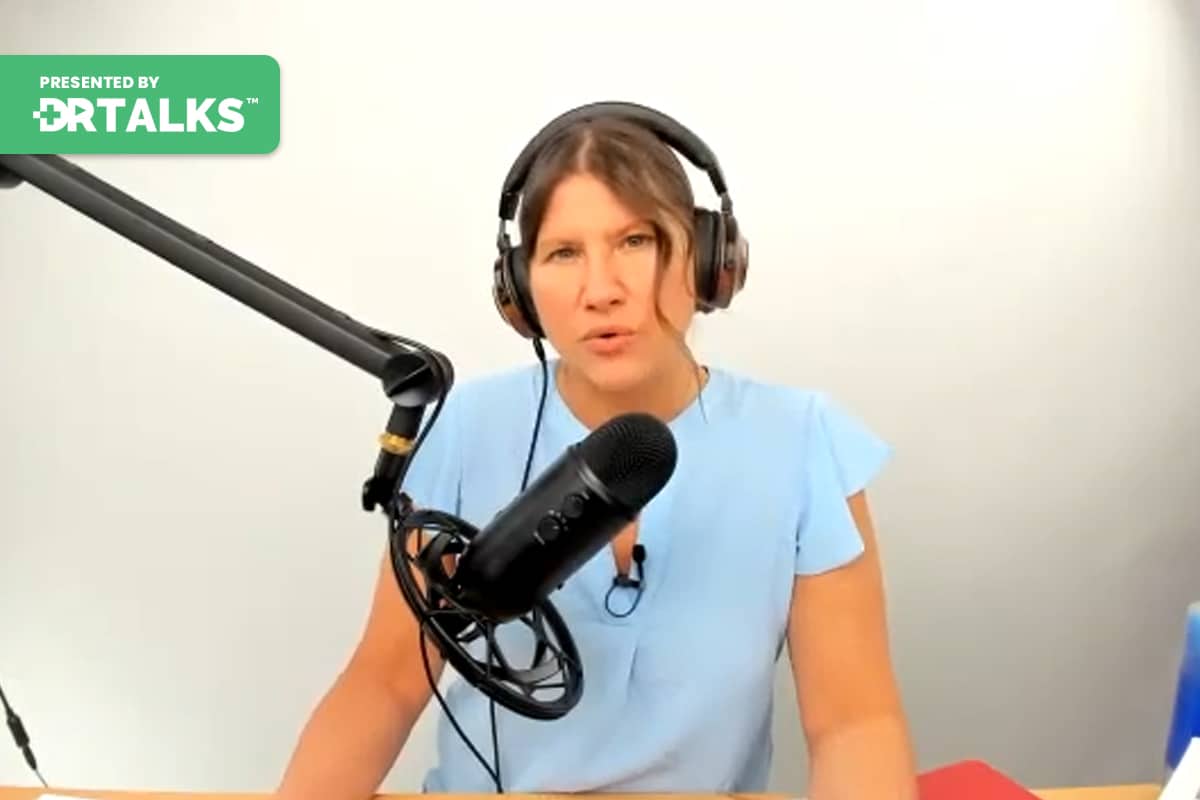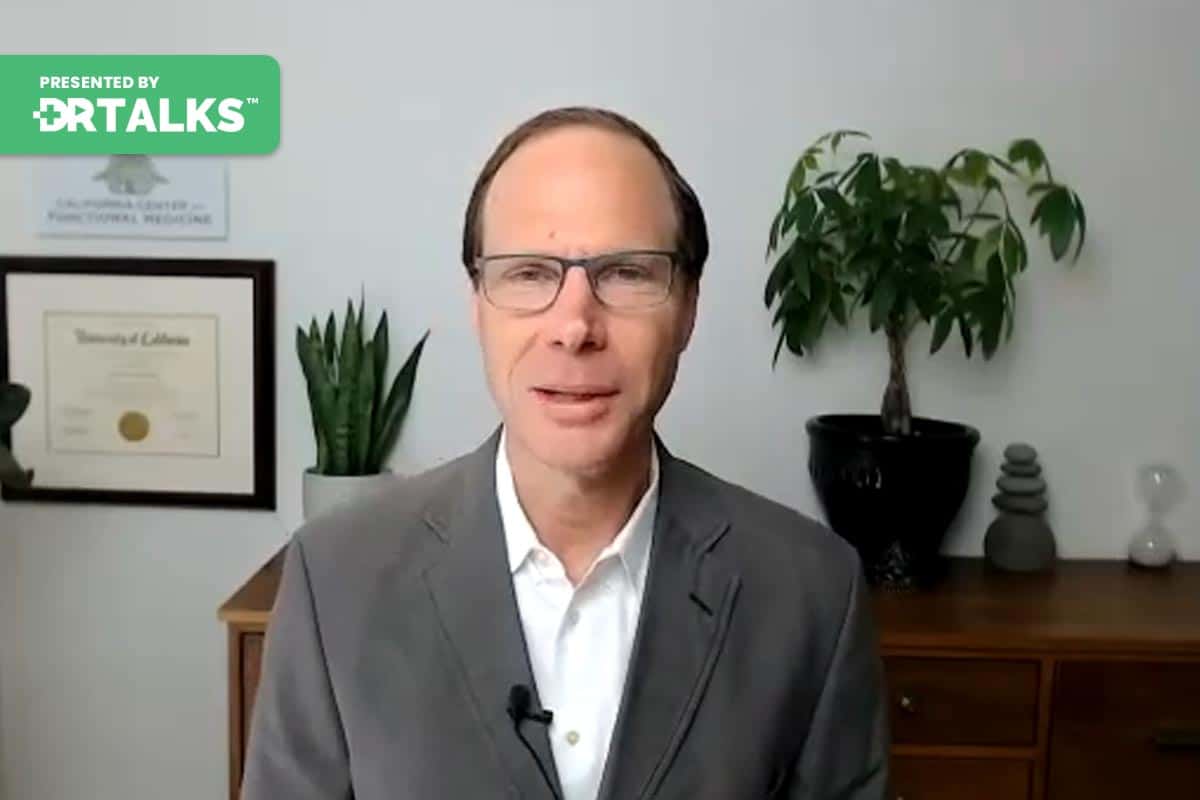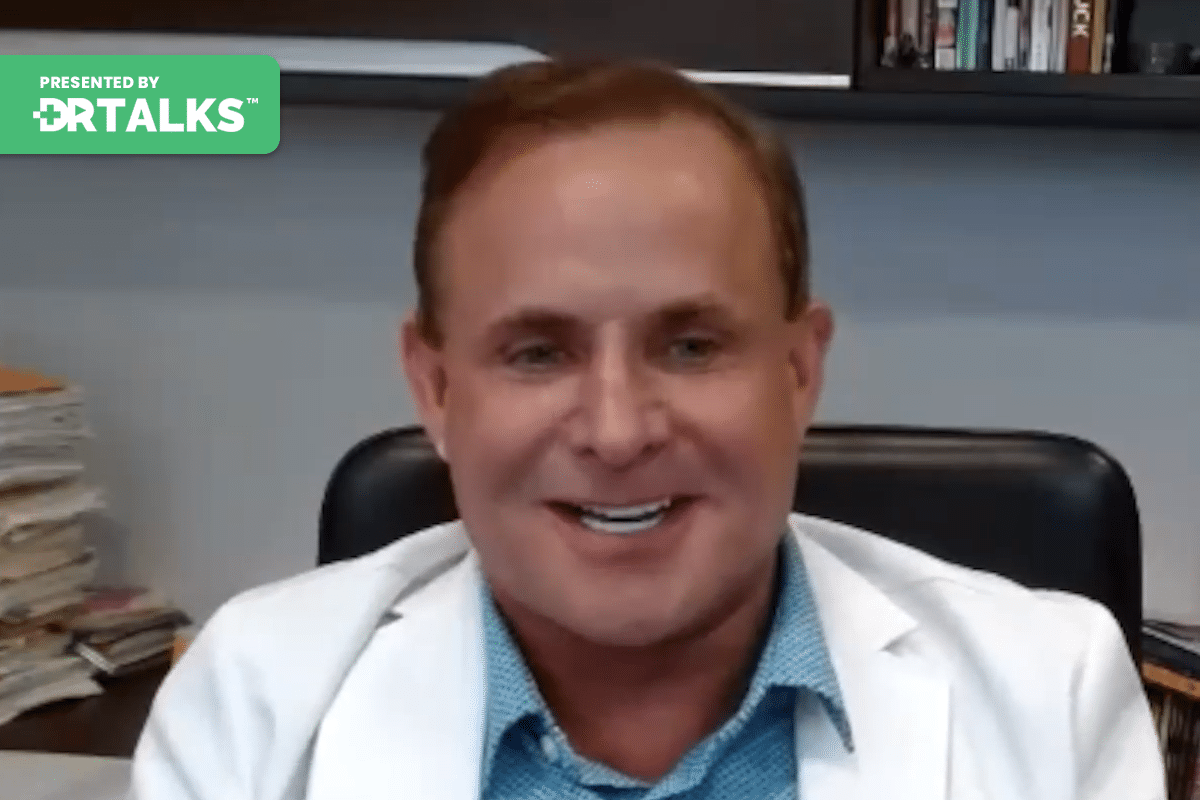Join the discussion below

Dr. Darin Ingels is a Licensed Naturopathic Doctor, Author, International Speaker, and leading authority on Lyme disease. He is a former Lyme patient who overcame his own 3-year battle with Lyme disease, after having failed conventional treatment and became progressively debilitated. Dr. Ingels found that proper diet, lifestyle management and... Read More

Dr. Rodger Murphree is a chiropractic physician and board certified nutritional specialist. He is an internationally recognized fibromyalgia expert. His “Murphree Method,” a combination of functional and orthomolecular medicine, has helped thousands of patients get healthy and feel good again. He’s the author of 3 books for patients and doctors including... Read More
- How fibromyalgia and Lyme disease relate to one another and how to know the difference
- Learn the many causes of fibromyalgia
- Understand the best ways to navigate pathways to overcome fibromyalgia
Related Topics
Central Sensitization Pain Syndrome, Chronic Fatigue Syndrome, Chronic Illness, Fatigue, Fibromyalgia, Heavy Metal Toxicity, Hormonal Imbalances, Immune System, Immune System Dysfunction, Infections, Joint Pain, Lyme, Lyme Disease, Medication Side Effects, Mold Toxins, Muscle Pain, Nerve Pain, Neuropathy, Pain Receptors, Serotonin, Sleep Disturbances, Stress, Treatment, Treatment ProtocolsDarin Ingels, ND
Tell everyone. And welcome back to the healing from Lyme Summit and today’s episode I get to talk to again a friend and a colleague, Dr. Rodger Murphree. And let me just give you a little background about Dr. Murphree. He’s a chiropractic physician in Birmingham, Alabama. He’s the author of Treating and Beating Fibromyalgia and Chronic Fatigue Syndrome. And he is an expert on fibromyalgia. And I, I want to connect the dots, because Lyme disease looks like so many different things, and fibro is one of them. So, Dr. Murphree, thank you so much for joining us on the summit today.
Rodger Murphree, DC, CNS
Well, Dr. Ingels, this is great. Thank you for I really am delighted to be here. And I’m looking forward to this conversation.
Darin Ingels, ND
You know, we call Lyme disease the great imitator, the great mimic. And, you know, I’ve had so many people come in to my practice who have been given a diagnosis like fibromyalgia, you know, maybe that’s a start. And talk a little bit about, you know, what is fiber? I mean, how do people know if this is what they have?
Rodger Murphree, DC, CNS
Well, unfortunately, you know, there’s a lot of misinformation out there about fibromyalgia, a lot of a lot of debate, whether it’s even real in some circles, unfortunately, that fibromyalgia is a syndrome. So a syndrome is a group of symptoms that people have in common. And we give it a name in fibromyalgia. Those symptoms include diffuse, achy, sometimes disabling pain, fatigue, brain fog, poor sleep, irritable bowel syndrome, and then the list can get quite long because they can have other issues. They can have comorbidity issues, anxiety and depression, chemical sensitivities, migraine headaches, interstitial societies. And, you know, typically I think what happens is that this individual has fibromyalgia, has a symptoms, goes to their primary care doctor, and he or she sees other symptoms and thinks, oh, my gosh, this is this. There’s no way someone can look like they do. I mean, they look okay. And yet they have all these symptoms and their tests are usually always, you know, pretty, pretty normal, at least in conventional tests. And they get branded sometimes as a hypochondriac, which nothing could be further from the truth. I mean, nobody want to make up this kind of stuff, but fibromyalgia typically affects women. 98% of those who come down with fibromyalgia are women between the age of 30 and 65. And it affects about 8% of the world population right now.
Darin Ingels, ND
Yeah, you know, it’s one of these frustrating things. You know, you go to the doctor and again, we see so many people that get gaslit around Lyme disease, around fibro, you know? Yeah, as you mentioned, is it a real diagnosis? And of course, it’s very real and it’s very challenging, I think, for so many people to deal with. Can you talk a little bit to I mean, I think there’s a sort of crossover between fibromyalgia, chronic fatigue syndrome, what we call myalgic encephalitis. You know, what is it that’s going on in this world that’s affecting the brain?
Rodger Murphree, DC, CNS
Well, so there’s you know, if you if you look at fibromyalgia and climatic syndrome, people sometimes get diagnosed with both those things, usually erroneously diagnosed or both of them, because I really find that while they have a lot of similarities, there’s some real differences between these two things. And so I talk about if you look at a clothesline and on one end of the closed line is fibromyalgia, what I call true fibromyalgia. And that individual has again, has diffuse, achy, sometimes disable pain, nerve pain, neuropathy, muscle pain, joint pain, and then they have fatigue, sometimes hard to even get out of bed. They always have difficulty with their sleep, either trouble falling asleep or staying asleep. They never feel refreshed when they wake up in the morning. They have low serotonin, this brain chemical called serotonin.
On the other end of the scale, people who have true chronic fatigue syndrome, those individuals can have trouble with their sleep and they typically have diffuse achy pain and they obviously have fatigue as the diagnosis implies, but they don’t always have low serotonin status and they are always have trouble with their sleep. In fact, for a lot of individuals with chronic fatigue syndrome, it’s not that they have trouble falling asleep or staying asleep. It’s that they want to sleep all the time. And I see the big difference between these two is a fibromyalgia that may or may not have an issue with your immune system. Those are complex in chronic fatigue syndrome, definitely have an issue with their immune system. They’re always fighting off some type of virus, bacterial infection, upper respiratory infection. They get random sore throats periodically, they get swollen glands. These are the individuals that really have to be careful getting out in public because they know that they’re vulnerable to catching any kind of bug that’s going around.
Darin Ingels, ND
Well, I think it’s pretty clear that, you know, infection is a trigger for fibromyalgia. Again, I see this with a lot of people with Lyme disease or any really any of the co-infections. Are there other underlying things that you’ve seen in your practice that are also causes of five other people need to be aware of?
Rodger Murphree, DC, CNS
Well, that’s that’s it, right? I mean, what’s the cause of five or March? I mean, that’s the question. And unfortunately, we really don’t know the true cause, although for the last 22 years, specializing in fibromyalgia, the thing that makes the most sense to me and many other health care specialists is this thing called central sensitization pain syndrome, where the those with fibromyalgia part of their nervous system, the autonomic nervous system, the sympathetic, sympathetic nervous system, which is very stimulating, is known over alert. It’s hyper vigilant. So because of that pain and any stimulation is magnified. So for these individuals, the pain receptors are hyper vigilant. They’re registering pain in an accentuated form. And it doesn’t matter where that pain is coming from.
So for them, you know, and I want surgery, so scar tissue or some type of past trauma that can be from osteoarthritis or osteoporosis, it can be from an autoimmune disease that’s triggering this. It can be from oxidative stress. It can be from other triggers that are coming. Wine that may be very new. You know, they had to they got under a lot of stress. And now Lyme starts to rear its ugly head, heavy metal toxicity, mold, toxins. These things start to build up that eventually, if this person gets under too much stress, they’re hypothalamus, pituitary, adrenals, which are kind of controlling this autonomic nervous system becomes compromised and now they start to develop symptoms that eventually we, you know, after a period of time, they get diagnosed with fibromyalgia.
Darin Ingels, ND
Well, I know you have your own unique approach, and I want to talk about that in just a little bit. But can we talk a little bit about medication? Because I know this is kind of the conventional approach for the doctors who do believe you and who are invested in treating you. You know, their approaches generally maybe around some physical therapy and medication. Is there a place for a medication in fibro? Is this something that you advocate people do while you’re working on dealing with these underlying issues? You know, what are your thoughts on, you know, if your doctor’s recommending something like Lyrica, Gabapentin, one of these medications?
Rodger Murphree, DC, CNS
Well, I found it’s you know, it’s really pretty much a dead end. Traditional medicine has pretty much given up on fibromyalgia. And that’s because over the years they’ve you know, they’ve come out with new medications, you know, saying, oh, yeah, this is you know, this is recommended for fibromyalgia, Lyrica, gravis, neurontin, gabapentin. So they are cymbalta. These are some of the drugs that are approved for fibromyalgia treatment. And yet when we look at the surveys, we see that after 15 years of being on Common Medical protocols, drug, you know, drug drug therapy alone, these individuals are no better off and usually they’re actually worse off. So what we’ve seen over the last decade is previously we thought, oh, yeah, we found a drug that would be able to cover up the symptom. A typical conventional medicine approach. And they would be able to get on with their life. What we see now is those drugs have not really yielded much long term success. So practitioners have become discouraged and they just tell their patients now, hey, we’re going to put you on this medication, but you’re just going to have to learn to live with it. It’s really, you know, no different than a lot of these medical misfit diagnosis is where people get a diagnosis, whether it’s Lyme disease or fibromyalgia and our country syndrome. And they’re told basically that, you know, we’re going to try to treat the symptoms, but that rarely results in any long term lasting relief for these folks.
Darin Ingels, ND
Yeah, I mean, that’s been my experience as well. And of course, most of these drugs come with a long list of side effects. And I find so many people, even if they’re getting some benefit from the medication more often, not the end of stopping the drug because of the side effects. It gets to the point where the side effects worse than the fibro itself, and it’s just not worth continuing. You know, walk us through your approach. You know, someone comes to you, they’ve been given this diagnosis of fibro, you know, with or without Lyme disease, you know, what’s your thought process? I know. Where do people really need to start? And you know how you kind of walk them through, you know, your treatment protocols for me?
Rodger Murphree, DC, CNS
Well, my protocols have changed over the years of being in practice through.
Darin Ingels, ND
They call practice.
Rodger Murphree, DC, CNS
I can’t believe 32 out of 32 years and treating fibromyalgia for 22 years. In the beginning here I had a very large integrative medical practice here in Birmingham, Alabama. And we did we used, you know, a combination of prescription medications, a very judicious use. We very limited use of these. And then more natural approaches. We in the clinic, we did MYERS Cocktails, ozone, we did hydrogen peroxide therapy, human growth hormone, all of these things. But what I found was that it became so complicated that it really backfired. You know, we could help the patient quickly if we gave they have trouble their sleep by giving them trazodone. You know, we became very, I think, lazy in our approach for these patients because we had too many, too many cooks in the kitchen. We had acupuncture, she had massage therapists, we had the RV clinic, we had dietitians. We had all these people trying to help these folks. And it really became so complicated that it wasn’t working. So 15 years ago or so, I sold that medical practice and I decided, okay, I’m going to figure this fibro thing out. I’m going to make it in an approach that anybody with fibro, whether I get to see them or not, can start the process of reversing the symptoms associated with fibromyalgia. So I wrote a book, my first edition, treating, beating fibromyalgia and crafting syndrome. And in that book, an outline kind of the the key things that have to happen for them to be able to get on the right path. You know, so many of them are off on the wrong path and spending a lot of money and a lot of time getting nowhere, working with either somebody or working with themselves.
And it’s very frustrating. They end up losing our hope. I wanted to kind of put, you know, here’s the map and here’s how you get from point A to point B, this is where you start now. That’s just the beginning. But what I found for these folks is the first step is getting them going into deep delta waves, sleep on a consistent basis. Without doing that, it didn’t matter what kind of therapy, what drug, but what natural nutraceutical we were using. They were not going to get any type of long term relief unless we can reestablish that deep restore to sleep. So that was the first big step and the first really aha moment for me 20, 20 something years ago was learning that, that if we if I got that right then everything would kind of start to fall into place. There’s another step in, another step in another step.
Darin Ingels, ND
So do you have specific strategies in helping? I know that’s such a huge problem. There’s only outline patient to a really struggle with getting that deep sleep. And now I advocate a lot of my patients get like a tracking device like I use an aura ring, some people use a Fitbit so you can really see how much light sleep, deep sleep, REM sleep you’re getting. And it’s such a struggle. Is it something that you’re doing through? Is it meditation, mindfulness or specific supplements? Do you have things that you’ve found? I know everyone’s different and you know, we’re not trying to give you medical advice, but are there certain things that you find really help people get over that hump of getting into that deeper sleep?
Rodger Murphree, DC, CNS
Yes. And this is really kind of one way to separate Lyme disease from fibromyalgia, because I think with Barbara maggi, they’re low on serotonin across the board. And so serotonin is your happy hormone is this brain chemical that raises your pain threshold. It’s important for mental clarity. You know, having those are fibromyalgia. I’ve often had this thing called fibro fog where they don’t think very clearly because they have problems with their mental clarity. Serotonin is very important to help you get into deep restorative sleep. And so individuals have fibro because they’re low in serotonin. This brain chemical, that’s where I start by using typically amino acid, mono amino acid therapy, in particular our tryptophan, or more often five hydroxy tryptophan, which is the breakdown of our tryptophan, plus key nutrients, B, vitamins, vitamin C, magnesium.
That combination is what makes serotonin. And by raising that serotonin level, we see that they start to increase their melatonin level by sometimes up to 200% and can start to reestablish that circadian rhythm along with taking the five HTP and a good multivitamin specific one that I’ve created over the years to make that serotonin reaction happen. Then you’re right. Then we use good sleep hygiene, you know, which is I think is very important, making sure that as the as the sun’s going down, which is a trigger for your for you to start to slow down, encouraged my patients to turn down the lights, start to disconnect their their electronic devices an hour or two before bedtime, get all electronic devices out of the bedroom. That’s really important. Blackout curtains, if they’re a real true hardcore insomniac, which most of these patients really struggle with their sleep, it can be a big challenge. I’m a recovering insomniac, so I know what it’s like. I used to wake up at 230, 3:00 in the morning and I just lay there for an hour or two or get up and start my day. I did that for a number of years. I could get away with it when I was younger and as I got older, I realized, you know, this, this is not good. I’m a part of it. I feel like a hypocrite because I’m trying to help my patients get a good night’s sleep, realizing the importance of that. And yet I was struggling years ago, I came up with a recipe that really works using a combination of gamma amino, dietrich acid, l-theanine ashwagandha, valerian root. Just a little supplement that I developed that for me it really totally resolves my my insomnia issues and I use that as well with my patients.
But you know, you think about every chronic illness out there if you’re not getting a good night’s sleep, you’re just fueling the flames of that illness. Yeah. I mean, if you’re not getting a good night’s sleep, obviously going to be tired the next day and these people hadn’t slept well in years. You can imagine our exhausted. They are there. If you’re not getting a good night’s sleep, we know that you increase your inflammatory chemicals by 40%. And you and I know that most everybody, it’s walking around, it’s got inflammation. And inflammation and stress are the two drivers of every condition, health condition out there. So we know people already got inflammation. Now you increase that by 40%. No wonder they’re walking around in a lot of pain. And what we see in fibromyalgia is they have a thing called Caledonia, which means low pain threshold. And part of that is due to this low serotonin, because when serotonin levels low, we get an increase of this thing called substance P, a hormone called substance P, which creates more pain. And so big thing for fibro is raising that pain threshold. And we do that by increasing the serotonin level with five HTP. So to me though, it doesn’t matter if I’m working with a large patient I work with on patients as well. I usually in combination with their fibro, but it really don’t matter. That’s the place to always start, is making sure that they’re getting deep restorative sleep on a consistent basis. Because if you do that, a lot of symptoms are going to start to improve.
Darin Ingels, ND
Great. So after we get the sleep under control, what’s sort of the next step for folks as well?
Rodger Murphree, DC, CNS
So the next step is really shoring up the nutritional deficiencies. So we know that everyone has nutritional deficiencies. The US government came out years ago and said that 70% of the population is deficient in at least one B vitamin, oftentimes as many as three or four. Now let me preface that when they say you’re deficient that they’re using the RDA, okay. The recommended dietary allowance, which you and I know really is inadequate for creating optimal health effects. I call the RDA the recommended disease allowance. It’s just enough to, you know, to keep you from getting scurvy or beriberi, you know, a bare minimum survive. Yeah, it’s but you know, it’s not going to move the needle right towards health. We’re you know we are it’s different on the inside as we are on the outside. And because of that, one person may need 500 milligrams of magnesium for them to get the optimal level two is, you know, magnesium is in 300 bodily processes. And it’s really important in the fibromyalgia communication because it’s a natural muscle relaxer. It also is important for making the neurotransmitters, the brain chemicals, including serotonin. But it also helps for those individuals have irritable bowel and are constipated so one person can take 500 milligrams and all of a sudden their constipation is corrected. Now they’re having a bad moment every day. Another person now, if they take a 100 milligrams of magnesium, they’re in the bathroom all day. You know, they have loose bowel movements. So we know that there’s a difference, you know, in how well or how poorly someone who can tolerate some of these essential nutrients.
So the second step really as shoring up the nutritional deficiencies with the right doses and combinations of vitamins, minerals, amino acids and essential fatty acids. And a big part of that for the fibro is getting the mitochondria, the power plants of the cells to work correctly. CoQ10 l-carnitine acetyl l-carnitine malic acid magnesium. These things that deliver the nutrients needed to make these mitochondria work. The next step, if I can go ahead. Now, just wrap this up real quick and take the next step then. Is shoring up any kind of GI problems? Because as you and I know, as functional medicine practitioners, you know, the health really is is tied to the gut. So many of these individuals have either leaky gut or yeast overgrowth or food allergies, something you’re very familiar with. They have malabsorption syndrome where they’re not digesting their food. They have reflux and bloating gas. Siebold They have all these different things going on. And if we don’t start to correct these GI problems, then, you know, they’re like the hamster on the wheel. They’re just running, you know, in circles because these GI issues are creating inflammation, creating pain.
Last but certainly not least, is adrenal fatigue. So these individuals have bankrupted their stress coping chemicals, and that’s why they need these high doses sometimes as these vitamins and minerals, amino acids and central fatty acids. But they’ve also put so much stress on their stress coping glands, the adrenal glands that they find that they’re depleted in these hormones, they need to be able to handle stress. So stress becomes more magnified. Bright lights, loud noises, real or imagined stress, it doesn’t matter. They can’t handle it. And they get to the point that it gets so bad that for some of them they can’t even leave the house because they can’t deal with the outside world. So the last but not least is shoring up any problems with their adrenal glands. Partly do, because if we don’t, then if they have a day where they feel good and, you know, they could be a rarity. But if they have a day where they’re feel good and they they go try to do something that you now would take for granted, you know, going out with friends for lunch or doing something in the garden or staying in extra hour at work if they’re still working, can send them over the edge and in there and think, Oh, they have a fibro flare that puts them in bed for two or three days. So those are really kind of what I talk about, the four corners of the puzzle, right? You know, you you want to get those four corners of the puzzle, right? And then you can start to put the puzzle together. But until you get the four corners, you’re really in a struggle with figuring out this puzzle, which is you. You know, your health your health puzzle.
Darin Ingels, ND
I think everyone listening is you’re walking through these steps and you’re talking about mitochondrial dysfunction, adrenal dysfunction. Most people with Lyme disease and these co-infections go on, ding, ding, ding, ding, ding. You know, that’s me. You know, we know that Lyme disease can directly damage your mitochondria. And if you’ve been on long term antibiotics, most of these antibiotics damage the mitochondria. So when you’re chronically fatigued and in pain and your tissue doesn’t recover as quickly as possible, a lot of that is because your mitochondria aren’t functioning nearly as well as they need to. And of course, the adrenal piece now we know that Lyme can cause thyroid problems. It can cause adrenal problems, reproductive hormone problems, and just the stress of being sick, you know, the toll it takes on you and your friends and your family and your loved ones. It’s a lot for so many people.
And I have a lot of Lyme patients again that become kind of night owls, not because they want to, but because their cortisol levels get so out of kilter that now, you know, nine and 10:00 heads and, you know, they’ve been tired all day long and they can barely function, but they get that little burst of at least mental energy that they have a hard time sleeping, and maybe that’s when they can be productive. So, you know, we’re seeing so many parallels between fibromyalgia and Lyme. And again, so many of my patients kind of have both. And I think, you know, you and I are approaching this in very much the same mindset that, you know, it’s not really just treat that one thing. We got to look at all these underlying factors, you know, looking at mitochondrial health, looking at gut function, looking at adrenal function and thyroid and all of these other pieces because it’s the whole of the person that gets you over that that hurdle and really get you starting to feel well. I want to ask you a little bit too about like diet specifically. You know, I talk about in my book, I kind of promote an alcohol and diet just based on what I did for myself when I had Lyme disease. And looking at the research, is there anything specific for fibro that you recommend for your folks?
Rodger Murphree, DC, CNS
Yeah, absolutely. So for me, the Paleo diet is probably the one that I think is probably the one that people do the best on are beta doc and be helpful as well. But really getting those grains out of their diet, definitely limiting or or eliminating simple, simple carbohydrates or, you know, sugars which create inflammation can be a real game changer. A lot of the patients that I work with there or carrying around a lot of extra weight from the sedentary lifestyle because just, you know, don’t have the energy to do this, you know, to lose that weight. Part of it is the medications sometimes that they’re taking. It’s not unusual. When I start working with a patient, they’re on half a dozen or a dozen drugs, you know, because in the conventional world, what it’s about is treating the symptoms. So the fibro, there’s so many dadgum symptoms. The same thing with wine that, you know, for, you know, what their own half a dozen or a dozen drugs, a drug to put them asleep, a drug to wake them up, a drug to slow them down, a drug to speed them up, you know, or all these things. So it’s easy. You know, this oftentimes it’s an easy next step that their metabolism becomes compromised and sabotages their thyroid. And next thing you know, they’re gaining weight from the medication or just from the metabolism being so low. And I find that having them be on an anti-inflammatory diet kind of based around similar like a paleo, although I’ve created a it’s called to transform, it’s a special diet for my patients to help them lose weight.
And part of that is combined with food allergy testing. So I’m a big believer that we need to know if there are any foods or reading on a daily basis that can be creating some of the symptoms that we have. But, you know, with fibro, you know, oftentimes these people who are really healthy and they’re, you know, they share their story. And here there’s, you know, a story with Lyme to, you know, they’re their exercise enthusiast. They’re working 40 hour work weeks or, you know, incredibly healthy people. Then something comes along. Typically, some type of stressor, and then they start to develop symptoms, maybe a few symptoms, aches and pains here and there. Then they start to have a little bit of fatigue. There’s sleep becomes compromised, and that’s where it all goes downhill. And then next thing you know, they’re, you know, after going back to doctor after doctor doctor, they finally get this diagnosis. It’s a fibromyalgia. But as that illness continues to rear its ugly head, they found that more and more things start to show up and they become more and more sensitive. So they find that the foods that they used to be able to eat, they can’t anymore, or things they used to do physically they can’t do anymore. It sets them off.
Or maybe they start to develop hay fever or never had seasonal allergies. Now they have seasonal allergies. And this is also part of putting that puzzle together is we see that, yeah, we get the four corners, but there’s other things that have to happen. You mentioned thyroid. Thyroid is a big one for these farmers. 60 to 70% of my patients with fibro have a problem with their thyroid. There’s never been properly diagnosed or not being properly treated. Also, and I hate to minute, but I will admit it. So the first lamb case I ever had 15 years ago, ten years ago, it’s been a long time, caught me by surprise. I had a patient with fibro and it hit every test you can imagine on her and never could get her out of pain. Everything had everything going in the right direction for her, sleeping great moods were stabilize. Mental clarity was pretty good. Energy was pretty good cleaned up, no pun intended, or IBS or I just it was just not on my radar. And I feel bad because, you know, I told her eventually after prayer time said, you know what, Mandi? I don’t know what else to do for you.
You know, I don’t, I don’t have anything else for you. And I felt bad. And looking back on it, too, I also had this, this. And I feel guilty. I had this mentality that there’s no way she could still have that pain. Something, you know, we tend to always test. We tried all these things that work for everybody else. So I was guilty of being one of those physicians that blamed it on the patient. Now, I don’t do that anymore. And usually I catch those who have Lyme and fibro because you know, the symptoms are so similar. I catch it in the interview, you know, I can catch that in an interview pretty quickly, but now routinely test just to make sure I’m not missing anything. That’s a piece of the puzzle that if I don’t get that right, we’re not going to be able to put the rest of it together.
Darin Ingels, ND
Well, you know, we’re all human. And I think every doctor I know, every doctor we’ve all been guilty of thinking that a patient made up a symptom or they they just weren’t right about what’s going on. And we miss things as much as we try. And, you know, again, this is why they call it practice. I mean, we’re learning from you every day. I mean, what I did early in my career, I don’t do most of that now because we learned either it didn’t work or there were other better ways to approach it. And that’s the benefit of experience of, you know, just doing a lot of this over and over. I mean, you train a lot of fiber folks. I treat a lot of Lyme folks. You know, we get to see, you know, all again, what works for most of the people, what’s likely to be beneficial, what’s likely to be harmful. And, you know, we keep constantly adjusting our process to fine tune it so that, you know, we really are able to present you with the best approach with the least possibility of having any kind of adverse side effects. So I appreciate you sharing and being honest with that because again, it happens to the best of us and in our best effort to help everyone get better. Sometimes we overlook things and it happens. So I appreciate you sharing that.
Rodger Murphree, DC, CNS
Well, I appreciate that. And you know what? It changes. You know, I mean, what I was doing even ten years ago, which was, you know, fibromyalgia, patients are slammed. No problem now, you know, and I think the universe that large kind of send you these people once you’re going to get comfortable with a select type of, you know, these are the linchpins if you do that, you’re they’re going to be fine. Well, now we’re seeing so many people, not only, you know, Lyme is a big one. You know, alarm is big, but the unknown is mold. You know, a few years ago, I have mold here and there now. Seems like everybody a test has mold. And Neil Nathan was on my fibro stomach, which, you know, I interviewed for. That was great interview that we did together. And I was talking to Neil. I said, you know, Neil, what do you see? And different about fibromyalgia. He’s been a Neil Nathan and wrote you familiar with him the book toxic I highly recommend it and he’s he wrote a book about fibromyalgia, too, or chronic illness. And so I asked I said, you know, what are you seeing different in the fibromyalgia?
Fibromyalgia patient that you weren’t seeing maybe five or six years ago? And he said, well, it used to be, you know, he named write it off a couple of things, but now it’s Islam. Lyme is big now and so his model. Yeah, I said, are you kidding me? That’s exactly what I’m saying. But it took me a few years to realize this pattern that I’m seeing. So many people are getting dinosaur fibro. But when you look at him, you see what is the main one of the main triggers? It’s mold or what’s one of the main triggers? Now it’s Lyme. And again, I go back to you see someone that’s really not, you know, doing pretty well, doing okay. Then something comes along. That’s the straw that breaks the camel’s back. And they develop these symptoms we call fibro. And but if you look deeper, you see that one of the triggers for them is Lyme. That may have been there for years. I never had an issue with it, but they got into too much stress. And now Lyme is rearing its ugly head. Or you know, it could be Epstein-Barr virus or, you know, which we see in lab to Epstein-Barr and cytomegalovirus, these herpes viruses that are co morbidities, things that are giving you issues in previously. And I never you know, people talked about Epstein-Barr virus that’s how I heard 22 years ago. I really found it in my fibro patients, in my private syndrome patients. Yes, but rarely in fibro. Now, guess what? Now I’m having to test everybody for, you know, Epstein-Barr virus antibodies to see if oh yeah, maybe there’s an FC more virus that’s been there dormant and now it’s starting to get this individual issues because they’ve gotten so rundown. So it changes to you know and I think that’s the to me that’s both a challenge. But it’s also really a lot of fun because you have to really stay up on what’s what’s, you know, out there, what’s happening. And we’re so toxic now, right? I mean, gosh, we’re so toxic. And that’s driving a lot of these illnesses.
Darin Ingels, ND
Now, I agree completely. And I have had a similar discussion with Dr. Nathan. And I think, you know, we’re all in agreement that our world is more toxic. You know, things that used to be, I say, easier to treat. It was never easy, but easier. It’s becoming so much harder. And whether it’s fibro, Lyme disease, autism, things that I used to see progress much more quickly with people. Now we’re seeing it’s taking two or three times as long to get that endpoint because, again, we’re constantly battling this toxic exposure mode, like you mentioned, is a huge one, but it’s pesticides and herbicides. I mean, I live in Southern California where we’re in a big bowl of pollution. And it’s just this accumulates over time and it makes our cells weaker. It makes them less efficient at doing what they’re designed to do.
So, again, you know, we keep doing our best efforts to detoxify in different ways. But, you know, I always think of as like filling up a bathtub and draining at the same time, you know, which process goes faster, we can drain it faster and fills up. We’re good, but it fills up fast and we can drain and it overflows and we start to have problems. So it’s really again about trying to lower that body burden on your body as much as possible. So I would advise, you know, go for that low hanging fruit now. Clean up your home, get all the chemicals out, be careful what you put on your what you’re putting in your mouth. All of these kind of things do help over time. But again, it has been a bit more challenging in the last decade to deal with some of these chronic illnesses as efficiently. I want to ask you a little bit, too, about exercise and movement. You know, so many people with fibro, Lyme disease, because of the pain, because of the stiffness, they really struggle to move. I mean, so how important is it and do you have good strategies to help people get some element of movement in their life?
Rodger Murphree, DC, CNS
Well, so Fabbro, I use this analogy that we’re all born of the stress coping savings account. I kind of mentioned that earlier, and in that stress coping savings can have certain chemicals that allow us to deal with stress hormones and vitamins and minerals and these things that we the body uses to be able to make these chemical reactions, to deal with stress, real or imagined for fibro. They bankrupted that stress coping savings account so they don’t have those chemicals. And as I mentioned, they have adrenal fatigue. So they have also their stress coping glands are shot. So stress really can set them back and they have these things go fibro flares. Exercise, which is a really healthy thing, is a stress. It’s a healthy stress. But for fibro, it’s not something that I recommend when I started working with them initially, although it has to be put in the equation for getting healthy because it’s like diet, you can’t be healthy with an unhealthy diet. Eventually it’s going to catch up with you. You can’t get to health, you know, you can’t be as healthy as you want to be with an unhealthy diet. And exercise is so important for fibromyalgia in particularly because they have a problem with, as I mentioned earlier, in mitochondria genetically just the way God made them. Many of them don’t have as many mitochondria. And the mitochondria that they have or decoupled, they’re not working correctly. So the mitochondria I mentioned earlier to the power plants of the cells, they give their cells energy, but they also communicate with other cells. And they’re driving these reactions inside of, say, other these little organelles in there.
One of the best ways to optimize your mitochondria energy and to build more mitochondria is exercise. So it’s something that can be a game changer. But in the beginning, until I can get that individual going in a deep restorative sleep, start to fix some of these underlying problems with their stress, coping deficiencies, chemical deficiencies. I don’t even start that now. I’ll get them to start moving because even moving can create additional metabolic energy. It can also can create more mitochondria energy movement that stimulates the vagal nerve is very important because the vagus nerve is our main nerve to drive. Parasympathetic reactions are calming reactions. The fibro they’re mostly driven by sympathetic reactions. So they’re just this wired and tired all the time, which is incredibly exhausting, you know, and creates a lot of inflammation, paying. So, yes, that’s a great question. But the answer is it’s got to be done in the right way and it’s got to be structured so that the individual doesn’t try to go out and exercise and then have a fibro flare and then feel guilty because they can’t do anything.
Darin Ingels, ND
Yeah, I mean, I advocate for I because I like the idea of sort of movement versus exercise. I think when people think of exercise like, Oh my God, I’ve got to go to the gym, I got to lift weights and like, my body’s just not going to happen. Yeah. You know, when I was in the throes of life and I was exhausted that I mean, if someone said, you need to go to the gym, I would have laughed in their face, like not going to happen. So I would litter, I would plop in front of the floor and watch TV and I would just stretch. Yeah, just stretch. And it didn’t seem like much, but from there it progressed that I would start just kind of doing laps around the house and then it was laps around the neighborhood and eventually got to a point. I started martial arts and I got a black belt in karate. So it took eight years to get to that point, but the idea of movement, because you’re moving your blood flow, you’re moving your lymph, that’s a good way we detoxify. And just mentally, it’s really, I think, helpful just to have some element of movement. So don’t feel like it has to be anything hardcore. It doesn’t sometimes even have to be that long. I have people that do, you know, gentle things like yoga and tai chi and qigong, people that then do like the little mini trampoline and just kind of bounce on it.
Rodger Murphree, DC, CNS
You know.
Darin Ingels, ND
There’s a lot of creative ways to get movement in your life that we may not initially consider. Exercise. But as your fitness level improves, as your energy improves, as your pain levels improve, I think just, you know, think about having some daily movement because again, I think that’s going to move the needle a lot faster.
Rodger Murphree, DC, CNS
Yeah. Yeah, I would agree. I mean, it’s got to be done the right way. But anybody can move and that’s I’ll take a similar approach is just getting them stretching in the beginning and then it could be once they’re doing better, we start to get those four corners of the puzzle name. We can be a little more aggressive and aggressive would be maybe, you know, walking 5 minutes a day and then you do that for a week and then you build up and then it’s 7 minutes and then a couple of weeks later, now you’re at ten. But eventually the idea is to get in the habit of doing something every day that does stress your body. So you build up that resistance because they’ve lost that neuroplasticity. They don’t have the, you know, the ability to rebound. They don’t they can’t rebound from stress. They don’t have the resistance or stamina. And the way you create that is by facing a stressful situation, including exercise, and then increasing that, getting over, getting used to it. And then and then and then challenging it again.
Darin Ingels, ND
Well, as usual, Rodger, this has been a fantastic talk. You’ve always got great pearls of wisdom to share with anyone around fibro. And I know so many people with Lyme disease have been struggling with this. I know people are tuning in, are going to be interested in maybe wanting to work with you. Where’s a great place for people to find you?
Rodger Murphree, DC, CNS
Well, thanks, dear. And this has been this is my favorite topic. I wish we didn’t have to talk about fibro. When I’m on these segments and podcast people, people say, oh, you know, I appreciate you being here. And I always say, Well, this is my favorite topic, but I wish we didn’t have to have it. The place to go is your fibro doctor. Doctor spelled out dot com and there’s all kind of free reports on there that you’ll find interesting some free videos about the Jumpstart process, which are the Four Corners of the puzzle. I go into detail 10 minutes each. I think of these video so not not a big time investment, but go into more detail. We kind of understand this process, what we’re trying to do with Fabbro.
Darin Ingels, ND
Well, always a pleasure, Rodger. We really appreciate you spending time with everyone on the summit and sharing your information. So again, thank you for being here and sharing your knowledge with us.
Rodger Murphree, DC, CNS
Thank you. Thank you, dear. I really enjoyed it. Thank you so much.
Downloads

